The selection of the mast is often overlooked when people start buying their windsurfing gear. However, it is a very important component for the correct performance of the sail. Therefore, when buying a sail you need to keep in mind what mast you are going to use with it, whether you already have it or if you are going to buy one.
The wrong mast will mess up the performance of even the best sail. When manufacturers are designing their sails, they do so around a specific mast (the one they manufacture of course). Therefore, using the wrong type of mast will deform the sail in the wrong way and so the sail will not perform as it was intended. Usually the easiest option is to buy the mast from the sail manufacturer but that can get pretty expensive.
The ultimate windsurf mast buying guide
So to give you the tools to buy an equivalent mast that won’t mess up the performance of your sail, here is a breakdown of the variables on a mast.
Composition
Since this is the easiest to check and the one that is usually commented on the most, let’s start here. Masts are usually made up of a combination of glass fibre and carbon, maybe even a little kevlar.
Carbon content
Carbon is a wonderful material as it recovers its original form quickly and is super light. It is generally accepted that the higher the carbon content, the better. So in an ideal world you would get yourself a 100% (OK, 100 is impossible, but as close as possible) carbon mast if it weren’t for two downsides:
- carbon is very expensive and so a mast that is only made of carbon will cost somewhere around the 1000 € mark.
- carbon, while very good at flexing back into shape, is extremely fragile when it comes to sharp hits. Dropping it in the car park can cause a minute crack which will cause the mast to snap the next time it is subjected to enough load like pumping or a hard gust.
Masts usually range from 30% to 100% carbon. However, us mortals usually will be sailing with something around the 60-80% mark. Only those who have the money and the skill to take advantage of 100% carbon like professional slalom sailors will make the investment.
Quick tip: older masts are made primarily with glass fibre. The main problem was when the mast broke you had to be super careful not to touch that part with your bare skin as it would irritate that area and be super itchy. If you come across a broken old mast, just remember to try as touch it as little as possible as the itch and rash can be quite a nightmare.
Stiffness and IMCS
The main issue of mast-sail compatibility comes (aside from the length) from the stiffness of the mast.
IMCS
Whereas the stiffness refers to how the flex of the top and the bottom half differ, the IMCS (Indexed Mast Check System) measures how much the mast deflects overall.
To measure the mast curvature a mast is rested at the ends and then has a 30kg weight hung at the centre. Then the mast is measured at the 1/4 point (lower half) and at the 3/4 point (upper half). The mast will bend slightly differently in the lower half than in the upper half, mostly due to the smaller diameter towards the top.
Stiffness
The overall stiffness of the mast is determined by how much the mast deflects at the mid-point. Getting this right is really important. The sail will perform differently if you have a mast has a stiffness different that for what the sail was designed for.
If the mast stiffness is higher than what is specified by manufacturer we have:
- A more stable sail, since it will deflect less
- More power since we have a tighter leech
- A fuller profile
- This is a better option for heavier riders as they will subject their sails (and masts) to more power and the correct mast might deflect too much for them.
If the mast stiffness is lower than what is specified by manufacturer we have:
- A less stable sail since it will deflect with each gust, changing the power in the leech
- Less power as the leech releases much of the power
- A flatter profile
- The sail will feel softer as the gusts are absorbed by the mast (like the suspension on a car)
- This is better for lighter riders who want more control and speed when sailing on choppy water
Bend Curve
Depending on how the composite fibres are oriented and how the thickness of the mast varies along its length, the mast will deform in one way or another. The difference in deflection between the 3/4 mark and the 1/4 mark is represented on a scale of 6 (hard/stiff top) to 20 (soft top).
Constant curve (9-15)
A mast is considered to be constant curve when the 1/4 and 3/4 points have a similar deflection.
Flexi top
When the 3/4 point deflects much more than the 1/4 point a mast os considered to be flexi top (16-20). There is also the option of hard tops which is when the top half is stiffer than the lower half (6-8).
The impact on our sailing can be summed up like this
Soft top:
- Looser leech
- Less power due to less active sail surface
- More control as the gusts are absorbed
- Centre of effort moves downwards due to the fact that the lower half of the sail is active
Hard top
- Tighter leech
- More power as with a tight leech we are using more sail surface
- Less control
- Centre of effort is moved higher
Thickness
Originally masts were all of the same thickness. These are Standard Diameter Masts (SDM). In recent years however the Reduced Diameter Mast (RDM) has been introduced. Here are the benefits and drawbacks of a RDM.
Benefits
- Easier to grab
- Harder to break due to the increase in wall thickness
- Lighter
Drawbacks
- Needs an adaptor for the boom to clamp around it
- Needs a reduced diameter mast base
- Fills with water faster when left in the water for too long
- More expensive
So which mast is for you?
So lets put all this information to use to make a decision on what to buy. Ultimately it all comes down to your weight, sail manufacturer and type of sailing.
Your weight
Ideally you get the most similar to what the manufacturer recommends. If you are heavier than average you go for a little stiffer, if you are lighter you will take a softer mast.
Wind speed
Strong and gusty winds: flex top
For a good all round performance: constant curve (probably your first choice)
Light winds: stiff top
Carbon
When it comes to carbon content, go for as high as you can afford as it will make your experience on the water that much more pleasurable. Just remember to treat it with care and avoid hard hits, but surely you are doing that anyways.
SDM or RDM
Since RDM’s are stronger they are key when sailing in waves. Also, since they are more easy to handle they work for most free-ride sailors.
If you are sailing on flat water and aiming for speed (big sails) you might prefer a SDM.
Maintenance
Avoid impact damage
As mentioned in nearly every section above, the masts integrity is radically reduced when it has a fracture. So, don’t drop it, don’t hit it with anything (especially during transport) and keep it in the air when in the shore break.
I have broken 2 masts just because the wave broke right on the mast. All that mass of water has a huge force and at some point the mast just can’t handle it. Even worse is when the mast is pointing towards the shore, sinks underwater and the wave hit the board causing the mast to get stuck in the sand/rocks. If you must have the sail in the water, make sure it is pointing to the wave and not away from it.
If your sail uses cambers, make sure they are working properly and are not causing wear to the mast.
Also, make sure you attach the boom only in the area designated for the boom to be attached (usually in a different colour). The main reason I prefer to use up to 8 people to get a stuck mast unstuck rather than 2 people with booms is that the booms can cause damage to the mast and the next time you are in the water it might break.
Avoid UV rays
Another factor to remember is that the UV rays are our greatest enemy when it comes to our windsurfing equipment. For the mast it is no different. If it is not in the sail, keep it out of the sun.
Second hand windsurf mast buying guide
Buying a second-hand mast can be a tricky thing mainly due to the fact that you don’t know how well it has been maintained. Here are a few things to keep in mind when shopping for a used mast.
Does it have any cracks or splinters, especially around the ferule?
Inspect the mast from top to bottom. Check the base, check the top. Check the area where the ferule meets the mast as some like to crack there.
Is the mast bent?
As masts are used they lose stiffness. At our surf center we have the issue that since we keep the sails rigged, the masts are constantly in tension. Over the course of one or two seasons the masts will not go back to their straight form when we take them out of the sails. This is not a major problem other than that the sail will always have a looser leech with less down-haul.
The only thing you should check here is that the bend is constant or only at the ferule. If it is at the ferule, inspect it more closely as it could be broken there.
Make sure you buy it separated
If you heeded my advice from the previous two points you will already have taken the mast apart. I just want you to avoid falling in the trap of buying a mast that is stuck to hard that you can’t break it down into 2 pieces to transport. You wouldn’t be the first to fall into this trap.
More resources on buying masts
For more articles on mast properties, check out these resources:
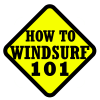

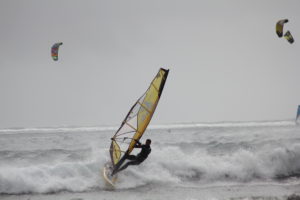
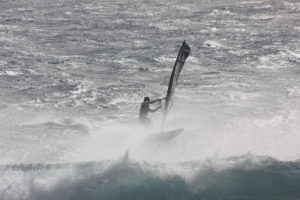
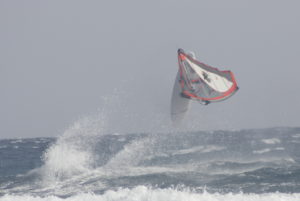
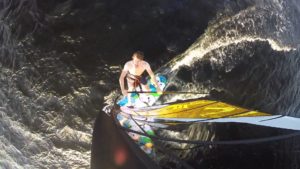
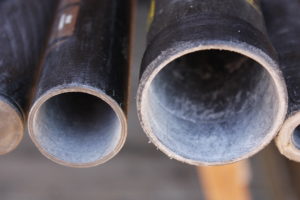
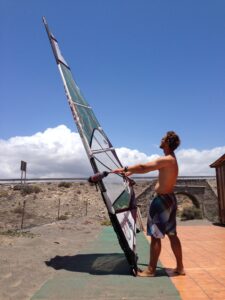
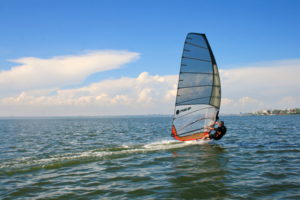
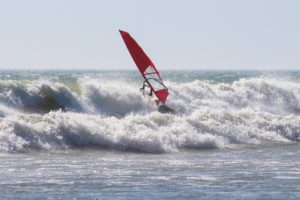



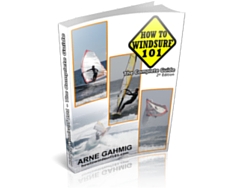
Thank you for this article. What do you think of Epoxy masts?
As of 2023, much of this information is out of date. Almost all booms have built-in RDM adapters. Nobody recommends different bend curves for the conditions. The bend curve situation is pretty much like this. A few brands are known to have very specific curve and you should not stray from that sail brand’s masts. For the rest, it’s pretty much constant curve to a moderate flex top and masts fairly compatible across brands.